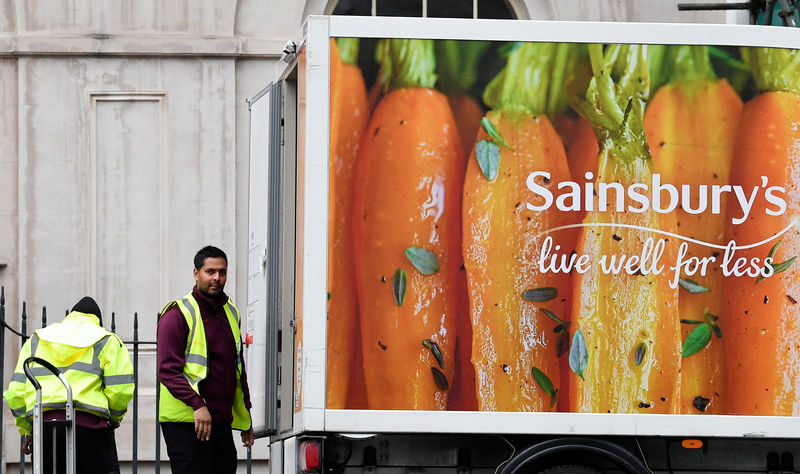This post was originally published on this site
https://i-invdn-com.akamaized.net/news/LYNXMPEE3T0BB_M.jpg © Reuters.
© Reuters.By Geoffrey Smith
Investing.com — ‘Live well for less’ looks like mutating into ‘live longer for a bit more’.
U.K. supermarket chain J Sainsbury (LON:) is placing a big bet on its customers being willing – and able – to accept the costs of going green.
The company said it will spend $1.31 billion over the next 20 years to make sure it’s carbon neutral by 2040, a full 10 years ahead of the U.K. government’s target for the country as a whole. The announcement sharpens its profile as a leader in sustainable corporate governance, one that admittedly hasn’t been able to reverse gradual long-term declines in market share.
“Only when the trajectory for global warming slows to a maximum of 1.5 degrees will we all know that we can truly live well for less now and in the future,” outgoing chief executive Mike Coupe said in an accompanying statement.
Sainsbury stock rose 0.4% by 5:30 AM ET (1030 GMT) on a day when the was broadly flat, licking its wounds after a sharp fall on Monday due to fears about the Chinese coronavirus. The benchmark index was down 0.1% and the German was down 0.2%.
Sainsbury will be spending the money on everything from making store refrigerators and lighting more energy-efficient to replacing plastic packaging, using low-carbon vans and trucks in its delivery fleet and optimizing water use.
For investors, the announcement raises two questions: can it pass the extra costs on to consumers without sacrificing market share or profit margins? And, will it be rewarded with a higher valuation by the swelling ranks of institutional investors who are under pressure to divert more of their assets under management to sustainably-run companies?
The costs are incremental. The average 50 million pounds a year of the initiatives announced is less than twice the 26 million annually that it has shelled out over the last decade. The extra 24 million it will be incurring in future represents around 4.5% of operating income over the last year. If it wants to maintain margins it will have to make some non-negligible efforts. However, it does at least have the comfort of having stemmed losses in market share over the last year: Kantar Worldpanel put its share at 16% over the Christmas holiday season, down only 0.1% from a year earlier.
As for how investors view the move, the chief problem that Sainsbury has is the sector and the country that it’s operating in. U.K. grocery retail is notoriously competitive and consumer confidence, after a bounce at the end of last year, will have to overcome persistent uncertainties over the post-Brexit future for the U.K. economy in 2020.
Tellingly, only six out of 17 analysts covering Sainsbury stock have a buy or overweight recommendation, according to Jones data. Compare that to a ratio of 14 out of 20 for LafargeHolcim, Europe’s largest player in a cement industry that is responsible for almost as many carbon dioxide emissions as passenger cars in the EU.
An FT report on Monday cited U.K. research house Redburn as downgrading both LafargeHolcim and Germany’s HeidelbergCement (DE:), due to expectations of sharp increases in carbon prices coming down the line from the EU. Neither company underperformed a broader market focused on more immediate concerns.
Fusion Media or anyone involved with Fusion Media will not accept any liability for loss or damage as a result of reliance on the information including data, quotes, charts and buy/sell signals contained within this website. Please be fully informed regarding the risks and costs associated with trading the financial markets, it is one of the riskiest investment forms possible.

